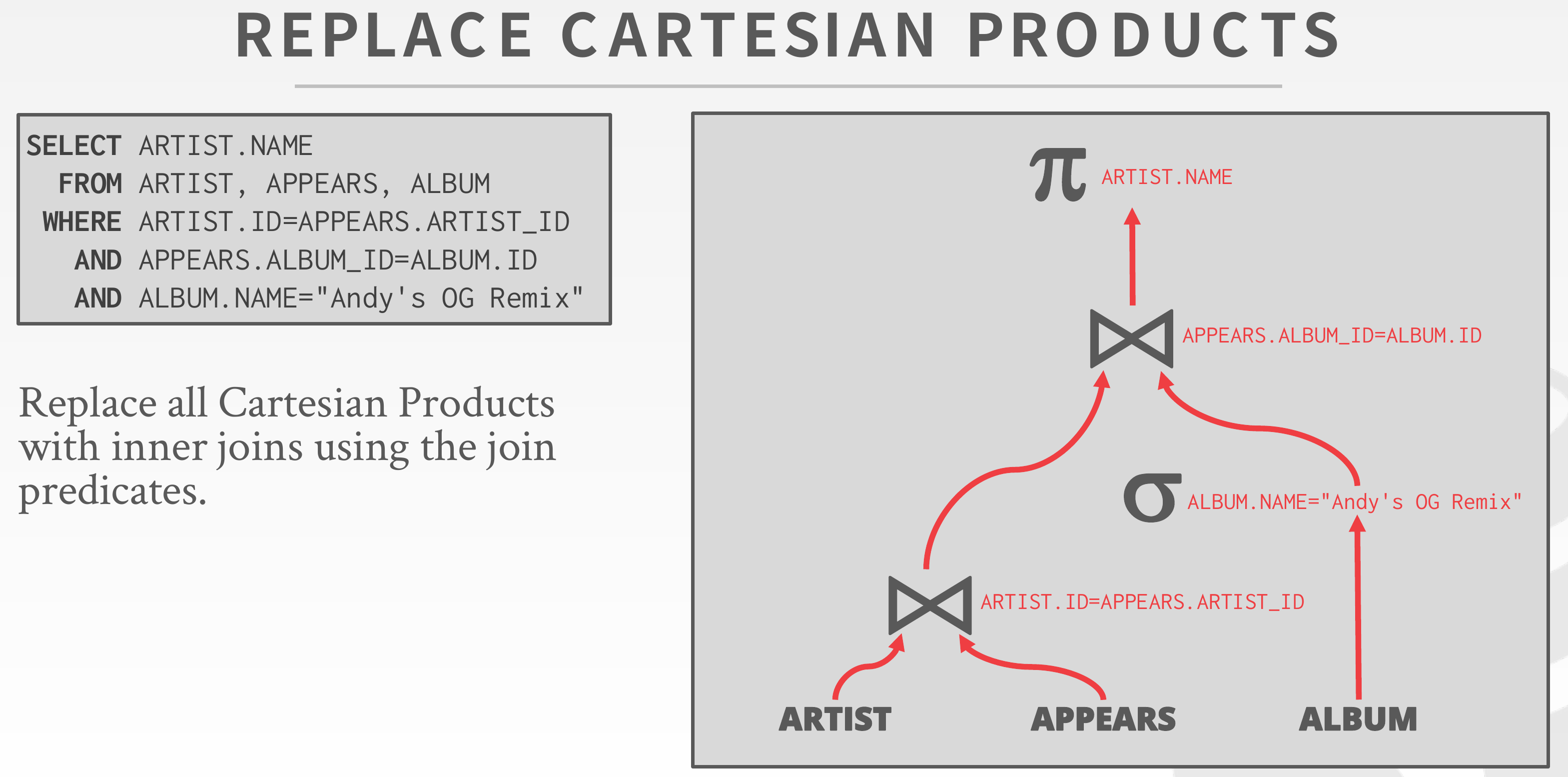Transform a logical plan into an ==equivalent logical plan== using ==pattern matching rules==.
The goal is to increase the likelihood of enumerating the optimal plan in the search.
==Cannot compare plans== because there is ==no cost model== but ==can "direct" a transformation to a preferred side==.
Transform a query plan's logical operators into physical operators.
- Add more execution information
- Select indexes / access paths
- Choose operator implementations
- Choose when to materialize (i.e., temp tables).
This stage must support cost model estimates.
All the queries we have looked at so far have had the following properties:
- Equi/Inner Joins
- Simple join predicates that reference only two tables.
- No cross products
Real-world queries are much more complex:
- Outer Joins
- Semi-joins
- Anti-joins
Approach #1: Transformation
- Modify some part of an existing query plan to transform it into an alternative plan that is equivalent.
Approach #2: Generative
- Assemble building blocks to generate a query plan.
Model the query as a hypergraph and then incrementally expand to enumerate new plans.
Algorithm Overview:
- Iterate connected sub-graphs and incrementally add new edges to other nodes to complete query plan.
- Use rules to determine which nodes the traversal is allowed to visit and expand.
Object-oriented implementation of the Volcano query optimizer.
Supports simplistic expression re-writing through a direct mapping function rather than an exhaustive search.
- Optimization tasks as data structures.
- Rules to place property enforcers.
- Ordering of moves by promise.
- Predicates as logical/physical operators.
A rule is a transformation of an expression to a logically equivalent expression.
- ==Transformation Rule==: Logical to Logical
- ==Implementation Rule==: Logical to Physical
Each rule is represented as a pair of attributes:
- ==Pattern==: Defines the structure of the logical expression that can be applied to the rule.
- ==Substitute==: Defines the structure of the result after applying the rule.
- Stores all previously explored alternatives in a compact graph structure / hash table.
- Equivalent operator trees and their corresponding plans are stored together in groups.
- Provides memoization, duplicate detection, and property + cost management.
PRINCIPLE OF OPTIMALITY
Every sub-plan of an optimal plan is itself optimal.
This allows the optimizer to restrict the search space to a smaller set of expressions. (注:即 ==branch-and-bound== search)
- The optimizer never has to consider a plan containing sub-plan P1 that has a greater cost than equivalent plan P2 with the same physical properties.
-
初始状态的 memo 如图所示,我们最终需要的结果是 [ABC] 三表 join cost 最小的执行计划,我们首先使用 Transformation Rule 得到 [ABC] 一个等价的 Logical Expression [AB] Join [C],接着我们进行==深度优先搜索==。
-
当搜索到最下层的时候,对 GET(A) 使用 Implementation Rule 生成 2 个 Physical Expression,然后找到 GET(A) cost 最小的 Physical Expression 是 SeqScan(A),并记录到 hash table 中。
-
同理找到 B 的最小 Physical Expression
-
然后搜索回到 [AB],通过 Transformation Rule 得到另一个等价的 Logical Expression [B] Join [A],这时我们发现 hash table 中已经有 Get(A) 和 Get(B) 的最优 Physical Expression 了,所以没必要继续搜索了。
-
然后对所有的 Logical Expression 应用 Implementation Rule 得到一些 Physical Expression,然后我们得到 [AB] cost 最小的 Physical Expression 是 [A] SM-Join [B],把它记录到 hash table 中。
-
搜索继续回到最上层,使用同样的方法找到 [C] cost 最小的 Physical Expression
-
然后对 [ABC] 应用 Transformation Rule 得到更多的 Logical Expression。
Tips:
- 在后面搜索的过程中,如果发现 cost 已经大于第一个的结果,可以使用 branch-and-bound 规则进行剪枝
- 在 Cascade 的论文中, Transformation Rule 和 Implementation Rule 是混合交替使用的,有一定的规则来决定顺序
Approach #1: Wall-clock Time
- Stop after the optimizer runs for some length of time.
Approach #2: Cost Threshold
- Stop when the optimizer finds a plan that has a lower cost than some threshold.
Approach #3: Transformation Exhaustion
- Stop when there are no more ways to transform the target plan. Usually done per group.
















